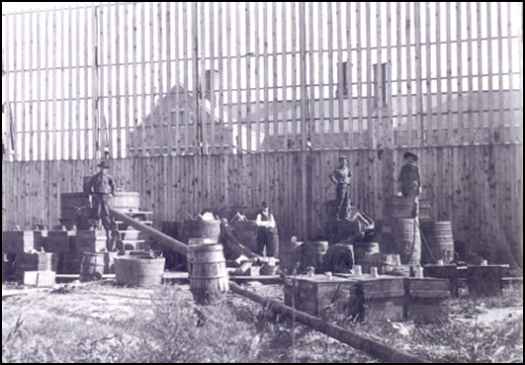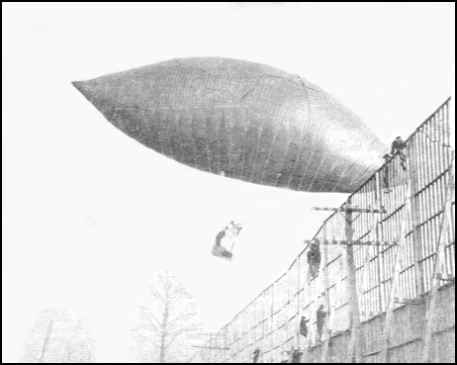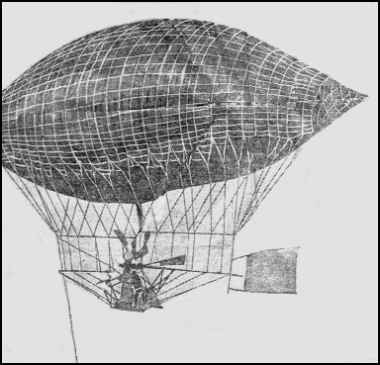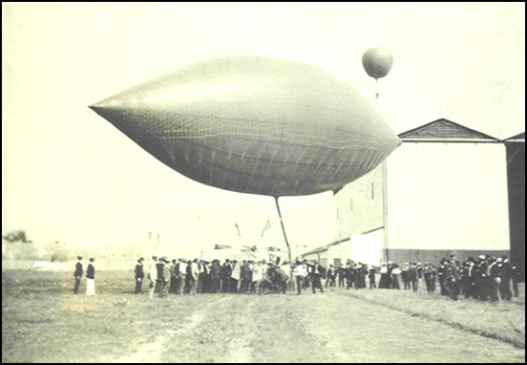
 |
|
St. Louis World Exposition, 1904 Courtesy of Jean-Pierre Lauwers |
 |
|
There is a hand written note on the back of the original photo: "This is how we used to have to make ouf 'gas'. I'm in the middle." T.C. is in the middle in the white shirt. Photo & caption from Cebe Hanson, 3-15-04 |
 |
|
Collection of Art Warren, 2-21-04 |
|
THE COLUMBUS NEWS, COLUMBUS, MONTANA THURSDAY, NOVEMBER 17, 1904 April 20, 1903 (Tri County News) - - The Benbow Airship trial at Red Lodge was of little value. Although the machine did not prove its efficency the promoters are by no means discouraged. The inferior and limited supply of gas failed to produce enough to fill the balloon . The next machine is to be built at the Myers Balloon Farm in Frankfort, N. Y. July 23, 1903 "S. T. Simonson, who recently went east to expedite the construction of the new Benbow flying machine, has written attorney G. W. Pierson of Red Lodge, concerning that enterprise. Prof. Myers, the celebrated balloon manufacturer and authority on air naviagation, is giving all the assistance he can in the construction of a practical airship. He is a firm believer in the machine, and his approval is not to be despised, as he is the owner of the balloon farm which furnished the U. S. govt. with its balloons. He has expressed his conviction that the Benbow machine is the only real airship in course of construction in the United States. The American Aerial Navigation Co. are wisely sparing no money in making their machine the best that skill and good materials can produce. Various motors have been rejected, because they were either too weak or lacked sufficient power. The simplicity and compactness of the Benbow machine was its material attraction and the source of more publicity than any other machine there, other than the Baldwin, "California Comet." Clippings from the St. Louis dailies prove that this was one of the most interesting features of the fair, and records a lot of bad luck for the Montana Meteor. Pat Lavelle, who was taking in the fair reported to the Tri County News "Sept. 22, 1904 - - "Another trial flight of the Benbow airship will occur today at the exposition, he being the only contestant so far to make a trial flight. The trial last week was sufficiently sucessful to convince the world fari officials and many others of the dirigibility of the shipl The big drawback was the lack of power to drive it successfully, but this has been remedied and I confidentially look for a successful flight shortly." September 29, 1904 - - Tri County News - - "Honorable Patrick Lavelle, who returned from St. Louis the first of the week, and who is a member of the Benbow Airship Company, says that another trial flight will occur today at the exposition. . There are presently three aeronaughts who will compete for the prize. They are T. C. Benbow, Captain Baldwin of San Francisco and Francis Conteaur of Paris, France. Benbow is ...ward, circular distance of the concourse. I intend to repeat tomorrow, in the middle of the day when it is warmer, and am confident the ship will perform perfectly." True to Lavelle's predictions, on Nov. 22, 1904 the Post Dispatch said: "After remaining in the air at a a height of over 2,000 feet for 45 minutes, a part of which time his machine was propelled by its own motor power, the Montana Meteor, designed and constructed by T. C. Benbow of Columbus, Montana, as brought safely to the ground in an open field three miles south-east of the World's Fair airdrome. Benbow stated that a leak in the gasoline tank allowed the fluid to escape so that the motor was useless, after running the propellors only while the fuel lasted - - hence the necessity of having to steer the machine to an open field for safe landing." This was the beginning of Benbow's bad luck. On his next trial with the machine in perfect running order, and a reinforced motor for extra power, he had circled the concourse, directing the machine perfectly, when he dicided to take the full 15-mile course. He ordered the guy lines cut and started up over the grounds, when an anchor slipped and caught in a tree, throwing the machine into some wires, where the wind....wires & lost in the darkness. When found some fifteen miles away, it had been damaged to such an extent that it too was disqualified for prize competition, which automatically closed the contest, as there were no others able to meet specifications. Still wishing to give the visitors to the fair a chance to see the machines in action, the directors offered a $500 daily prize for a flight around the concourse, and it was in a trial for this that Mr. Benbow had his third encounter with misfortune........... Collection of Art Warren, 2-21-04 |
 |
|
Collection of Art Warren, 2-21-04 |
|
TREE PREVENTS ST. LOUIS POST DISPATCH FRIDAY, NOVEMBER 18, 1904 TRIED TO SURPRISE CROWD BY UNHERALDED ASCENT Not Losing His Nerve From Accident, He Makes Preparation for Possible Second Attempt fo Fly Over Fair. "Montana Meteor" Cuts Loose, but Anchor Catches Fence and Second Obstacle Prevents Successful Get-Away from Earth. Moved by an impulse to do, unannounced, what he had failed to do when announced, T. C. Benbow got ready this afternoon to make his airship, the Montana Meteor, flap its wings and fly. Shortly before 2 o'clock, with the assistance of his lieutenant, Harry Wells, he supervised the taking of his ship from the aerodrome to the aeronautic concourse. For three-quarters of an hour he and Wells hustled themselves going over the mechanism and seeing that everything was right for a flight. The people sauntering by the concourse saw that there was likely to be something ........... About 2:40 o'clock, .......he thoroughly tested his motor several times and found that it was working perfectly, and had taken another look at the weather, he announced that he would certainly set sail. At that time his ship was west of the aerodrome headed toward the southwest. The purpose of Benbow was to sail to the Plaza of St. Louis and back to the aeronautic concourse. The airship at this time was some 75 feet above the earth, and was tugging upon the rope in a way which made it pitch violently. Benbow's position was perilous, but he exhibited much presence of mind and held only the rigging while he gave orders to those below. He lowered a second rope, and had some of the men go through the fence and pull him away, which slacked the anchor rope and enabled them to clear it. Benbow them ordered them to release the other rope, and as they did so his ship bounded away to fresh disaster. There was a tree straight ahead. Benbow did his utmost to avoid it, but the stiff breeze drove his light craft fairly into the tree top, and one of the trailing ropes caught, giving him a secure anchorage and bringing the ship around with a bang at the stern, tearing and breaking the rudder. Benbow's position now became more perilous than ever,. The ship was clear of the tree, but it pitched, violently, and the aeronaut was forced to cling to the rigging with all his strength to keep from being dashed to the ground. The spectators expected him to be thrown out at any moment, but Benbow seemed equal to the emergency. He was quite cool and had the courage to release his hold...... |
 |
|
World Exposition, 1904 Courtesy of Art Warren, 2-21-04 |
|
Benbow Makes Another Ascension and Controls His Airship Benbow's craft drifted in a south-westerly direction, as Benbow stated before he arose that he would not start his motors until sufficient gas had been allowed to escape from the gas bag of his craft to make the ascent perfectly safe. The bag, it seems, had been overloaded and Benbow feared an explosion in case the gas expanded. Benbow's course was south and westward until the Philippines reservation was reached. There he stopped the escape of gas and started the motors working. They responded immediately. For a few moments the craft displayed considerable dirigibility. The ship was then 2,000 feet high and was going in a southerly direction. The Meteor then turned westward. A moment later it turned completely around and started northward. It seemed to be coming straight back to the concourse. Then it began zigzagged in the air. It looked for a moment as if control of it had been lost. Then it turned westward and disappeared in the distance. Among those present to watch the ascent was Audrey Knabenshue, who, made the successful flights with the Baldwin airship. At 4 P. M. the Benbow airship came down and landed at Lindenwood, three miles south of the World' fair. A number of persons had followed the course of the Meteor in automobiles and these came up shortly after the aeronaut had come to earth. Collection of Art Warren, 2-21-04 |


|